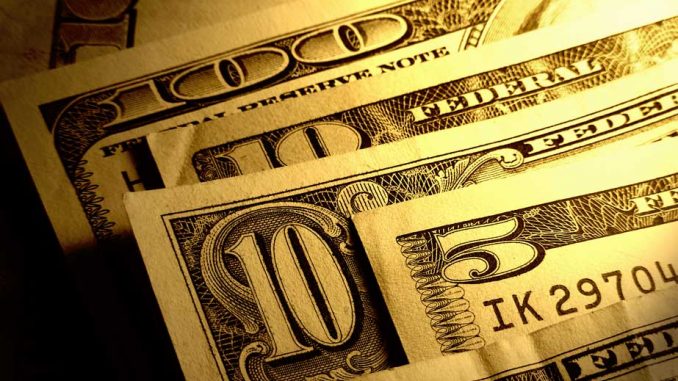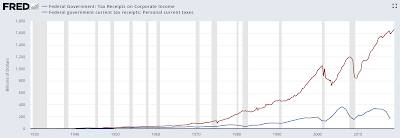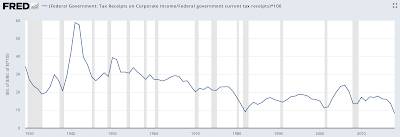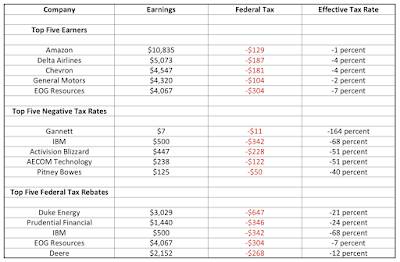
Thanks to the Trump Administration's tax reengineering and research done by the Institute on Taxation and Economic Policy, we now know how the changes to America's corporate tax regime benefitted Corporate America.
While Main Street America pays the lion's share of Washington's tax revenue as shown on this graphic:
…the situation has worsened since the introduction of Donald Trump's 2017 Tax Cuts and Jobs Act with corporations now remitting only 8.1 percent of the federal government's total tax receipts, the lowest level since the Great Depression as shown here:
To compound the issue, research by the Institute on Taxation and Economic Policy (ITEP) found that 60 of America's largest publicly-held profitable corporations paid absolutely no corporate income tax in 2018, more than twice as many as the average in previous years. These companies earned $79 billion in U.S. pre-tax income and, rather than paying $16.4 billion in corporate income tax at the new 21 percent statutory corporate tax rate, they benefitted from a net corporate tax rebate of $4.3 billion.
Here are the top five earning companies that paid no tax (or received tax rebates) in order of earnings, the top five companies that had negative tax rates and the top five companies that received federal tax rebates:
As you can see, some of these companies are highly profitable and are among America's largest corporations. If you wish to see the entire list of 60 corporations, please click here.
Obviously, these companies are using a variety of legal tax breaks to write down their earnings to zero (or less). Here are the most common:
1.) Accelerated Depreciation – allows companies to write off the cost of their capital investments (in equipment etcetera) at a much faster rate than these investments actually wear out. For instance, Halliburton's use of depreciation-related tax breaks allow the company to reduce its taxes by $320 million.
2.) Stock Options – allows companies to write off stock-option related expenses in excess of the cost that they report to shareholders. A 2016 study by Citizens for Tax Justice found that this legal tax break was used by 315 of the Fortune 500 companies and is one of the main reasons why stock options have become such an important part of executive compensation packages. As one example, the highly profitable Amazon reduced its federal income taxes by over $1 billion in 2018 using this tax break.
3.) Fossil Fuel Tax Subsidies – allows companies to depreciate their oil and natural gas assets. As one example, these tax breaks allowed Pioneer Natural Resources reduced its federal tax owing to $0 on $1.2 billion of its income in 2018.
4.) Tax Credits – allow companies to claim tax credits for research and development. As one example, thanks to $140 million in R&D tax credits (among others), Netflix ultimately received $22 million in federal tax credits on earnings of $856 million.
One would like to think that the corporate tax reductions introduced by the 2017 Tax Cuts and Jobs Act would have led to the creation of jobs or higher wages for workers but this is not clear. What it has led to are two things:
1.) An increase in U.S. corporate stock buybacks which reached $1.1 trillion in 2018. For the first three-quarters of 2018, buybacks were $583.4 billion, up 52.6 percent from 2017 while aggregate capital investment increased by only 8.8 percent and R&D investment grew by only 12.5 percent on a year-over-year basis.
2.) An increase in dividends paid to shareholders. Based on the first eleven months of 2019, dividends paid hit a new record of $420 billion, up from $419.7 billion the in the prior year, another record year. The beneficiaries of increased dividends flow mostly to large shareholders (i.e. Named Executive Officers and holders of large numbers of shares) while little of the benefit of dividends flows to Main Street America and their small shareholdings.
As we can see, the corporate tax cut of 2017 has proven to be very beneficial to a select number of Americans and their corporate employers, however, the benefits of the tax reduction have not flowed down to "Mom and Pop" who are playing a larger and larger share of Washington's tax revenue. Since Washington's lawmakers are largely bought by Corporate America and its political donations, this should be of no surprise to anyone. At least America's legislators know how to look after their corporate overlords.
Click HERE to read more from this author.
You can publish this article on your website as long as you provide a link back to this page.




Be the first to comment